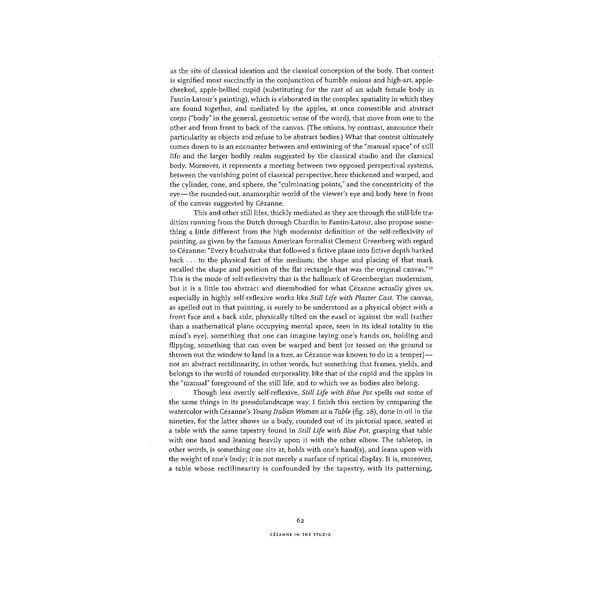as the site of classical ideation and the classical conception of the body. That contest is signified most succinctly in the conjunction of humble onions and high-art, apple- cheeked, apple-bellied cupid (substituting for the cast of an adult female body in Fantin-Latour's painting), which is elaborated in the complex spatiality in which they are found together, and mediated by the apples, at once comestible and abstract corps ("body" in the general, geometric sense of the word), that move from one to the other and from front to back of the canvas. (The onions, by contrast, announce their particularity as objects and refuse to be abstract bodies.) What that contest ultimately comes down to is an encounter between and entwining of the "manual space" of still life and the larger bodily realm suggested by the classical studio and the classical body. Moreover, it represents a meeting between two opposed perspectival systems, between the vanishing point of classical perspective, here thickened and warped, and the cylinder, cone, and sphere, the "culminating points," and the concentricity of the eye—the rounded-out, anamorphic world of the viewer's eye and body here in front of the canvas suggested by Cézanne. This and other still lifes, thickly mediated as they are through the still-life tra- dition running from the Dutch through Chardin to Fantin-Latour, also propose some- thing a little different from the high modernist definition of the self-reflexivity of painting, as given by the famous American formalist Clement Greenberg with regard to Cézanne: "Every brushstroke that followed a fictive plane into fictive depth harked back ... to the physical fact of the medium; the shape and placing of that mark recalled the shape and position of the flat rectangle that was the original canvas."19 This is the mode of self-reflexivity that is the hallmark of Greenbergian modernism, but it is a little too abstract and disembodied for what Cézanne actually gives us, especially in highly self-reflexive works like Still Life with Plaster Cast The canvas, as spelled out in that painting, is surely to be understood as a physical object with a front face and a back side, physically tilted on the easel or against the wall (rather than a mathematical plane occupying mental space, seen in its ideal totality in the mind's eye), something that one can imagine laying one's hands on, holding and flipping, something that can even be warped and bent (or tossed on the ground or thrown out the window to land in a tree, as Cézanne was known to do in a temper) — not an abstract rectilinearity, in other words, but something that frames, yields, and belongs to the world of rounded corporeality, like that of the cupid and the apples in the "manual" foreground of the still life, and to which we as bodies also belong. Though less overtly self-reflexive, Still Life with Blue Pot spells out some of the same things in its pseudolandscape way. I finish this section by comparing the watercolor with Cezanne's Young Italian Woman at a Table (fig. 28), done in oil in the nineties, for the latter shows us a body, rounded out of its pictorial space, seated at a table with the same tapestry found in Still Life with Blue Pot grasping that table f with one hand and leaning heavily upon it with the other elbow. The tabletop, in other words, is something one sits at, holds with one's hand(s), and leans upon with the weight of one's body; it is not merely a surface of optical display. It is, moreover, a table whose rectilinearity is confounded by the tapestry, with its patterning, 62 CÉZANNE IN THE STUDIO
 Cézanne in the Studio: Still Life in Watercolors Page 76 Page 78
Cézanne in the Studio: Still Life in Watercolors Page 76 Page 78